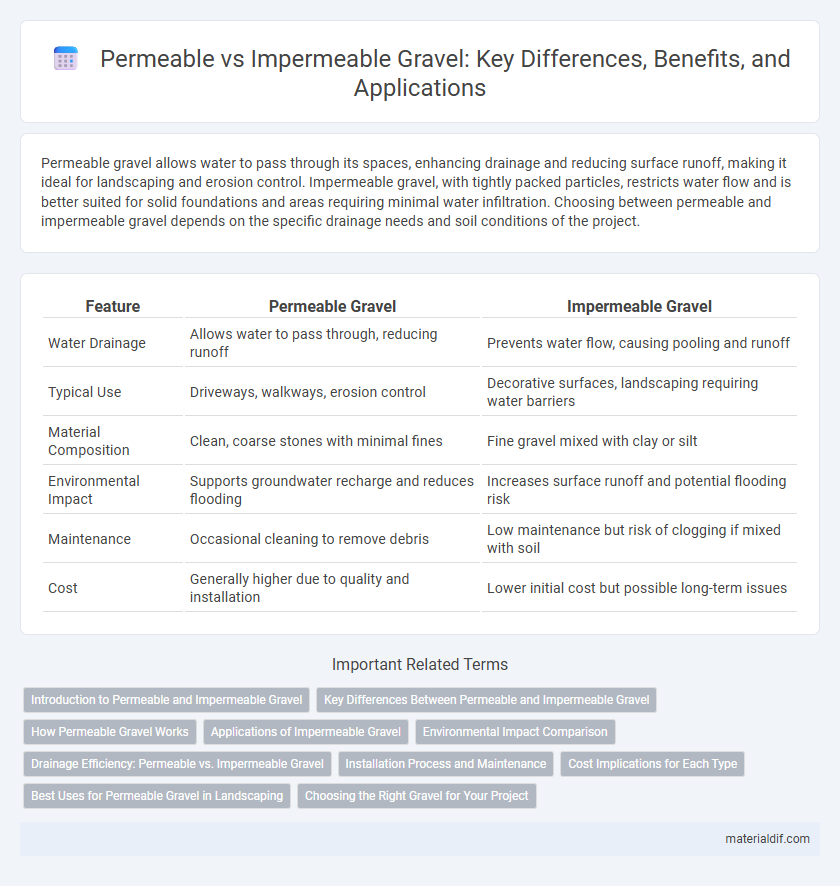Permeable gravel allows water to pass through its spaces, enhancing drainage and reducing surface runoff, making it ideal for landscaping and erosion control. Impermeable gravel, with tightly packed particles, restricts water flow and is better suited for solid foundations and areas requiring minimal water infiltration. Choosing between permeable and impermeable gravel depends on the specific drainage needs and soil conditions of the project.
Table of Comparison
| Feature | Permeable Gravel | Impermeable Gravel |
|---|---|---|
| Water Drainage | Allows water to pass through, reducing runoff | Prevents water flow, causing pooling and runoff |
| Typical Use | Driveways, walkways, erosion control | Decorative surfaces, landscaping requiring water barriers |
| Material Composition | Clean, coarse stones with minimal fines | Fine gravel mixed with clay or silt |
| Environmental Impact | Supports groundwater recharge and reduces flooding | Increases surface runoff and potential flooding risk |
| Maintenance | Occasional cleaning to remove debris | Low maintenance but risk of clogging if mixed with soil |
| Cost | Generally higher due to quality and installation | Lower initial cost but possible long-term issues |
Introduction to Permeable and Impermeable Gravel
Permeable gravel allows water to pass through its spaces, facilitating natural drainage and reducing runoff, making it ideal for sustainable landscaping and erosion control. Impermeable gravel, on the other hand, compacts tightly to create a solid surface that prevents water infiltration, often used in foundational and structural applications where moisture resistance is required. Understanding the permeability of gravel is crucial for selecting the right material based on drainage needs and environmental impact.
Key Differences Between Permeable and Impermeable Gravel
Permeable gravel allows water to pass through its porous structure, enhancing drainage and reducing surface runoff, making it ideal for sustainable landscaping and erosion control. Impermeable gravel, often compacted or mixed with finer particles, restricts water flow, which can lead to water pooling and increased surface runoff. The key differences lie in their water permeability, impact on soil moisture levels, and effectiveness in managing stormwater.
How Permeable Gravel Works
Permeable gravel consists of larger, angular particles with void spaces that allow water to infiltrate and pass through the material, promoting natural drainage and reducing surface runoff. This type of gravel is crucial in managing stormwater by filtering pollutants and recharging groundwater supplies. Unlike impermeable gravel, which compacts tightly and prevents water flow, permeable gravel maintains porosity essential for sustainable water management in landscaping and construction.
Applications of Impermeable Gravel
Impermeable gravel is primarily used in construction projects where water retention is critical, such as foundation bases and retaining wall backfills to prevent water infiltration. Its low permeability makes it ideal for creating barriers that control groundwater flow, protecting structural integrity in roads and buildings. Additionally, impermeable gravel serves as a reliable material in landscaping applications requiring minimal drainage to maintain soil stability.
Environmental Impact Comparison
Permeable gravel allows water to infiltrate soil, reducing runoff and minimizing erosion, which supports groundwater recharge and mitigates flooding. Impermeable gravel prevents water absorption, leading to increased surface runoff that can cause soil degradation and water pollution. Choosing permeable gravel enhances sustainable stormwater management and promotes healthier ecosystems by maintaining natural water cycles.
Drainage Efficiency: Permeable vs. Impermeable Gravel
Permeable gravel significantly enhances drainage efficiency by allowing water to flow freely through its porous structure, reducing surface runoff and preventing water pooling. Impermeable gravel, in contrast, restricts water infiltration, leading to increased runoff and potential erosion issues. Choosing permeable gravel supports sustainable water management and reduces strain on stormwater systems.
Installation Process and Maintenance
Permeable gravel requires careful installation with a layered base system designed to facilitate water infiltration, including a geotextile fabric to prevent soil contamination and promote drainage. Maintenance involves periodic removal of debris and sediment to maintain permeability and prevent clogging. Impermeable gravel installations focus on compacted sub-base layers and do not require drainage systems, with maintenance primarily involving surface cleaning and replenishing gravel as needed.
Cost Implications for Each Type
Permeable gravel, designed to allow water infiltration, often incurs higher initial costs due to specialized materials and installation techniques aimed at enhancing drainage. Impermeable gravel, which restricts water flow, generally has lower upfront expenses but may lead to increased long-term costs from water runoff management and potential structural damage. Evaluating cost implications requires considering both installation expenses and future maintenance related to drainage efficiency.
Best Uses for Permeable Gravel in Landscaping
Permeable gravel allows water to pass through, making it ideal for landscaping areas requiring drainage, such as walkways, driveways, and rain gardens. It reduces runoff, prevents erosion, and supports sustainable water management by promoting groundwater recharge. In contrast, impermeable gravel blocks water flow, causing pooling and potential damage in wet environments.
Choosing the Right Gravel for Your Project
Permeable gravel, characterized by its larger, irregularly shaped particles, facilitates efficient water drainage and reduces runoff, making it ideal for landscaping and drainage projects. Impermeable gravel, often composed of finer particles or compacted materials, provides a solid, stable surface suitable for driveways and construction bases where water retention is necessary. Selecting the right gravel depends on the specific project requirements for drainage, stability, and environmental impact.
Permeable Gravel vs Impermeable Gravel Infographic

 materialdif.com
materialdif.com